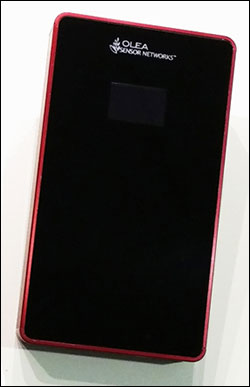Last month, Olea Sensor Networks, a Sunnyvale, Calif.-based startup, introduced its sensor platform, made to enable end users to differentiate animate from inanimate objects—and even to determine whether animate objects are human or non-human. The company is now working with a number of businesses on pilot programs to test safety applications.
Olea Sensor Networks’ president, Frank Morese, says the key to the company’s technology is a set of proprietary algorithms that process data collected from the firm’s OS-3001 multi-sensor device, which is roughly the size of a smartphone. The OS-3001 includes a Doppler radar sensor that transmits a 5.8 GHz signal and collects the backscatter signal that bounces off objects within its field of interrogation. An animate object, such as a human body, will absorb some of the energy, while a wall or boulder will not. Additionally, animate objects constantly make very small movements, which inanimate objects do not.
The Olea algorithm uses these different “signatures,” as Morese calls them, to determine whether or not objects are animate. Further, the Doppler sensor collects heartbeat and respiration patterns from animate objects, and the software then determines if the animate object is human or non-human, based on those patterns.
“The sensor looks for reflected energy,” Morese says, “and in that way, it is similar to an infrared sensor.” He notes, however, that an important difference is that infrared technology does not work when the sensor is pointed directly into sunlight.
The Doppler sensor can also operate in total darkness, Morese says, and has a range of 5 to 10 meters (16.4 to 32.8 feet).
The OS-3001 contains a magnetometer, an accelerometer, a gyroscope, an altimeter, and a temperature and humidity sensor. A GPS module is optional. It also includes a display and Olea software that runs onboard, while Olea’s graphical user interface software can be used to access the data remotely.
The device connects via a micro-USB port for a wired connection to a host computer, but can also connect to a local network over Bluetooth or Wi-Fi. The company plans to offer a GSM/GPRS cellular add-on module in the future.
Morese says target markets include automakers, who could use the technology to power a safety-alert system that would trigger an alarm if, say, a small child or pet was behind a vehicle but outside the driver’s view. If the device were installed inside a vehicle, it could be used to monitor the health of drivers or passengers.
Security systems could also use Olea Sensor Networks technology to monitor a facility for human intruders. “You might have a convention center with 2 or 3 million square feet of space, but only two security guards,” Morese says, citing one example. Guard dogs could help monitor the space, and Olea’s technology could be set to trigger alarms only if it detected one or more persons.
Olea Sensor Networks is currently developing a pilot program with an emergency response company and an automaker, in which the sensors, located inside car seats, track the heartbeats and respiration patterns of passengers and transmit this data to the first-responders via the vehicle’s telemetry system. The goal of the pilot, which involves 60 vehicles and drivers, is to provide a proof of concept regarding the collecting and logging of vital signs. In the event of an accident, the emergency-response team could begin accessing the data even before reaching the injured parties. This would be especially useful, Morese says, for cases in which passengers are unconscious and, therefore, unable to describe their condition over a voice-based emergency communication system integrated into the vehicle.
Nondisclosure agreements preclude Morese from naming the parties involved in these pilots, he says.
In another pilot, the Olea device is being tested for use as an occupancy sensor inside hotel rooms. Occupancy sensors that rely on movement generally fail to show that a person is inside a room while he or she is sleeping or injured, and that has implications for room temperature controls—a room’s air conditioning might stop cooling a room while its occupants are sleeping, for example—as well as for emergency services. “If there is a fire,” Morese states, “first-responders want to know which rooms contain people, and they to know whether they’re humans or pets.”
Thirdly, a forklift manufacturer is integrating the Olea sensor device into forklifts used in busy warehouses, so that warehouse managers can improve safety. “They want the system to detect humans near the vehicle [to alert the driver],” Morese explains, “and also want to log near-misses and better understand how the driver is behaving.” Eventually, he says, the sensor could be integrated into the forklift’s controls in order to automatically stop it if it is danger of colliding with a person.
NASA recently deployed two prototype devices that utilize technology similar to Olea Sensors Networks’ in Nepal, to search under rubble for survivors of the 7.8 magnitude earthquake. The NASA technology, known as Finding Individuals for Disaster and Emergency Response (FINDER), led rescuers to four survivors—and this was the first time it managed to save lives in a real emergency.


